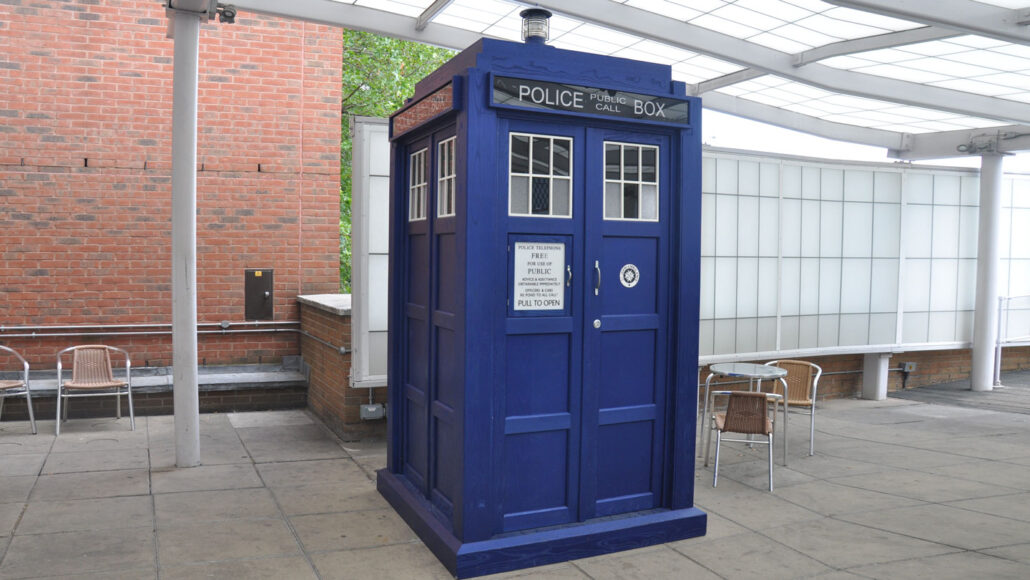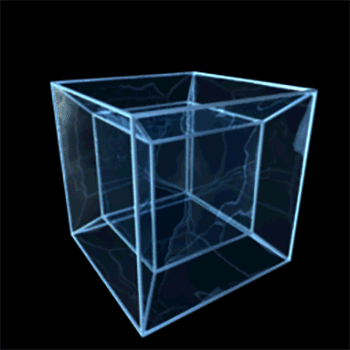Doctor Who’s TARDIS is bigger on the inside — but how?
Scientists have some ideas about how the Doctor’s blue box might work

Doctor Who’s TARDIS may look small on the outside, but it’s got plenty of space inside. How does that work?
Babbel1996/Wikimedia Commons (CC BY 2.5)
Often in science fiction, a time machine or spacecraft looks like something from the future. A sleek silver disk, or a high-tech space plane. The British television show Doctor Who, though, is a bit different. Its combination time machine/spacecraft, known as the TARDIS, looks like a blue police box you might have found in England in the 1960s. And it’s hiding a secret: It’s bigger on the inside.
When someone first enters the TARDIS, their jaws usually drop. Outside, the blue box is not much bigger than a phone booth or a bathroom stall. But inside, there’s a huge control room with curving walls. And then there’s a doorway that leads off to many more rooms. They contain everything from a library and guest quarters to closets full of clothes to a swimming pool.
But can anything really be bigger on the inside than the outside? Physics has a few answers. They aren’t impossible. But two-hearted aliens from Gallifrey aside, no one will be building a TARDIS anytime soon.
Wibbly-wobbly, timey-wimey stuff
TARDIS is an acronym that stands for “time and relative dimension in space.” The blue box can travel anywhere in the universe and arrive at any point in time. This makes it the perfect ship for a space tourist. And while it looks like it should be a cramped ride, it’s not.
“The TARDIS is one of my favorite concepts,” says Mika McKinnon. “Not only is it bigger on the inside than the outside, it also changes appearance.” (It can become invisible when necessary.) McKinnon is a physicist who helps science fiction television shows and movies make sure they’ve got their science right. But making something bigger on the inside than the outside, McKinnon says, “is a tricky one.”
J.J. Eldridge is an astrophysicist — someone who studies objects in space — at the University of Auckland in New Zealand. The official explanation, they note, that the alien Doctor gives to puzzled companions is that the TARDIS is “dimensionally transcendental.” That means that the inside and the outside of the ship exist in separate dimensions. A dimension is just “a direction you can measure in,” Eldridge explains.
Dimensions allow scientists to locate something in space and time. Based on this explanation, the inside of the TARDIS exists in one place in space and time. The outside is in another dimension, someplace else, and at some other time. The outside of the TARDIS might be in modern day England. The inside, though, could be on the moon, millions of years from now. What could bring the inside and outside together?
Wormholes and tesseracts
To solve this problem, Eldridge says, maybe the Doctor needs a wormhole. This is a tunnel that can connect two points in space and time. “We know they exist,” Eldridge explains. Or rather, scientists know that they could exist. But no human has ever seen one. “We just know it’s mathematically possible.”
A wormhole could connect the outside of the TARDIS with the larger inside. “If you wanted to make a TARDIS in our space, you would take a wormhole and curve your spacetime out to somewhere else to where you’ve stored the TARDIS,” Eldridge says. The outside of the TARDIS could travel anywhere or to any time. The inside would stay in the same place. A faraway planet, for example, with lots of space for control rooms and swimming pools.
But, McKinnon asks, why stop at just one wormhole? A wormhole is just a portal. “I think it’s more fun to think of [the TARDIS] as a series of looped portals,” she says. There would be one wormhole in the main doorway, she explains. But each doorway inside could also have its own wormhole. That means plenty of closet space.
Wormholes, though, are only one way to explain the TARDIS’ roomy interior. Another way the Doctor describes the inside of the TARDIS is this: Think about looking through a picture frame. On the other side of the picture frame, far away, is a much larger box. Because someone is looking through the picture frame and the box is a long way away, the large box might seem small enough to fit through the picture frame. But that’s just because it’s far away. In reality, it’s much bigger. In the TARDIS, someone steps through the picture frame, and directly into the second, larger box, traveling incredibly far with a single step.
But you can’t just step from one small cube to another huge cube a long way away, says Erin Macdonald. She is an astrophysicist who educates people about space science. “When I started thinking about this, it reminded me of the tesseract,” she says. This is a special kind of cube. (It’s also the name of a device in the Marvel universe, which is something completely different, as is the tesseract of A Wrinkle in Time.)

Normal cubes on Earth have three dimensions — length, width and height. But a tesseract has four dimensions. Often, time is described as the fourth dimension, but not in this case, McKinnon notes. “Instead of time as the fourth dimension, it’s an extra dimension of space.”
The third dimension of a cube means that cubes are bigger than they look. If someone stares at only one side of a cube, they might think it’s small. It looks like just a square. But a cube extends back behind the front square, where the person can’t see it. “In reality, it has six times the space” of the original square, Macdonald explains.
Add another dimension to make a tesseract, and there’s even more space inside. We would perceive a cube (or a police box). But a tesseract would extend into another dimension that we can’t see. That would provide a lot of extra space, Macdonald says.
In fact, it would have eight times the space of the cube a person could see. “People who see the TARDIS are doing the same thing as looking down on a cube,” Macdonald explains. “They’re seeing a four-dimensional object appear to be a cube, and then once you go inside, there are higher dimensions there.”
The good thing about a tesseract is that the Doctor doesn’t have to bend time and space to use it. Instead, the alien just needs access to a different dimension. However, at only eight times the size of the original blue box. “It’s still not big enough to hold swimming pools and a costume shop,” Macdonald notes.
There’s probably no way that people could ever build something like the TARDIS. “But that’s part of the fun” of putting science into science fiction, Macdonald says. “[The TV producers] give us something, and we try to make it work.”
Technically Fiction is a blog that finds the science in the realm of the fantastic. Have a comment or a suggestion for a future post? Send an email to sns@sciencenews.org.







